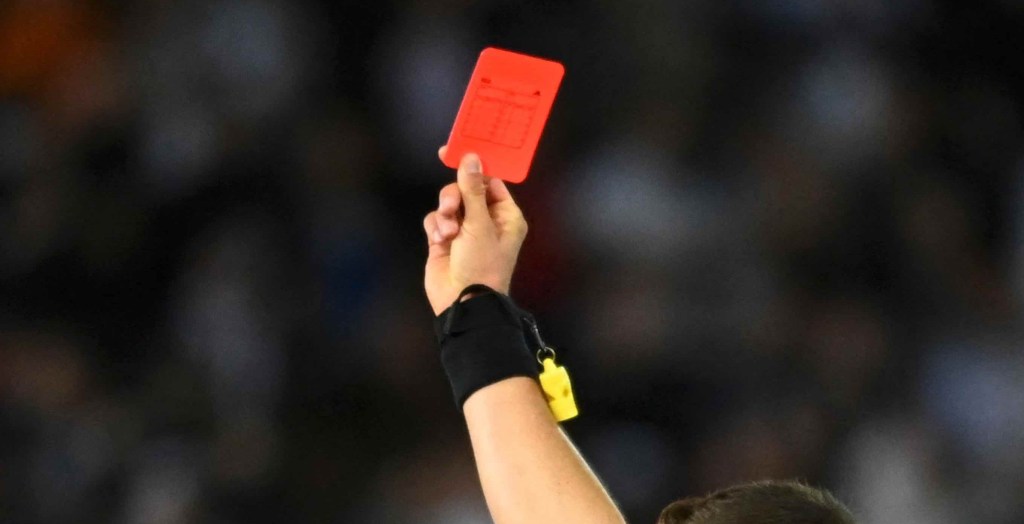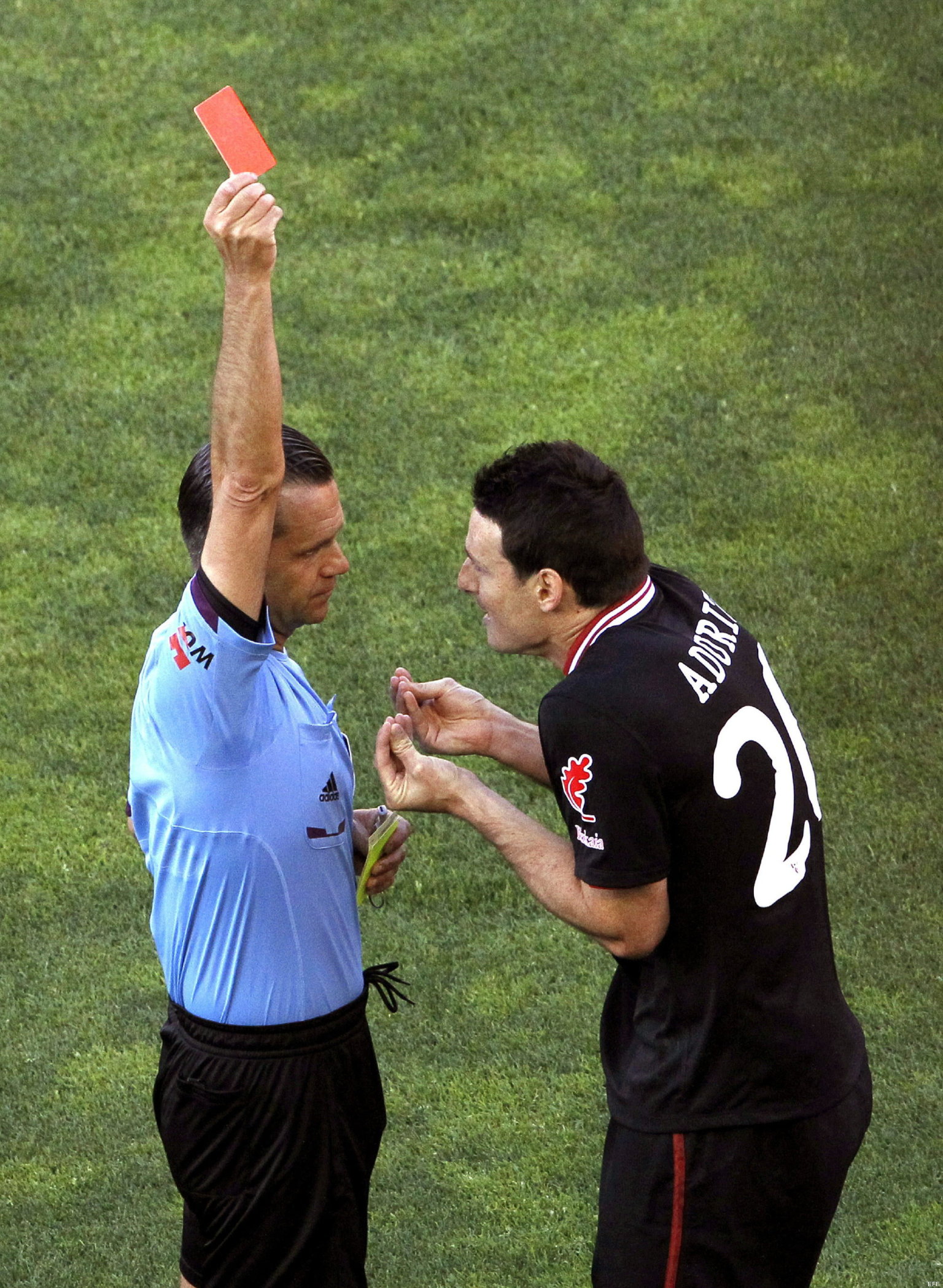Red cards have always been a hot topic in the world of sports, especially in soccer. Whether you're a die-hard fan or just someone who enjoys watching the occasional match, the sight of a red card can send shockwaves through the stadium and change the course of a game in an instant. But what exactly is a red card, and why does it hold so much power? In this article, we'll dive deep into the world of red cards, exploring their history, rules, and the impact they have on players and teams.
Imagine this: you're at a crucial match, the tension is high, and suddenly, the referee pulls out that dreaded red card. The player's reaction, the coach's frustration, and the fans' outrage all add to the drama. But beyond the spectacle, there's a lot more to red cards than meets the eye. Understanding the rules and consequences is essential for anyone who wants to appreciate the game fully.
Whether you're a seasoned player, a passionate supporter, or just someone curious about the mechanics of soccer, this article is here to break it all down for you. We'll cover everything from the origins of the red card to its modern-day implications. So, buckle up and get ready to learn everything you need to know about the infamous red card!
Read also:Unlock The Power Of Remoteiot P2p With Raspberry Pi Your Ultimate Guide
What Exactly is a Red Card?
A red card, often referred to as "tarjeta roja" in Spanish, is one of the most severe disciplinary actions a referee can take during a soccer match. It's more than just a piece of colored cardboard; it represents the ultimate punishment for misconduct on the field. When a player receives a red card, they are immediately sent off the field, and their team must continue the match with one fewer player. This can have massive consequences, especially in competitive matches where every player counts.
History and Origins
The concept of the red card dates back to the 1970 FIFA World Cup in England. Before this, referees relied solely on verbal warnings and gestures to communicate with players. However, language barriers often caused confusion, leading to the introduction of the red and yellow card system. The idea was simple yet effective: a yellow card for a warning and a red card for expulsion. This system quickly became standard in international soccer and has since been adopted by other sports as well.
Rules Surrounding Red Cards
Knowing the rules is crucial if you want to understand how red cards work. According to FIFA regulations, a player can receive a red card for a variety of offenses, ranging from violent behavior to denying an obvious goal-scoring opportunity. Let's break down some of the key scenarios where a red card might be issued:
- Violent conduct or serious foul play
- Spitting at an opponent or any other person
- Using offensive, insulting, or abusive language
- Receiving two yellow cards in the same match
- Denying an obvious goal-scoring opportunity through handball or a foul
These rules are designed to maintain discipline and fairness on the field, ensuring that players behave with integrity and respect for the game.
Consequences of a Red Card
Getting a red card isn't just about leaving the field early; it comes with serious repercussions. Players who receive a red card are often suspended for one or more matches, depending on the severity of the offense. This can significantly impact both the individual player's career and the team's performance, especially if the player is a key member of the squad. Additionally, the team is forced to play with one fewer player, making it much harder to maintain control of the game.
The Psychological Impact of Red Cards
While the rules and consequences of red cards are clear, their psychological impact is often overlooked. Imagine being a player who just received a red card. The emotions can be overwhelming: shame, frustration, and even anger. This emotional turmoil can affect not only the player but also their teammates, who may feel the pressure of playing short-handed. Coaches and managers also face the challenge of motivating their team despite the disadvantage.
Read also:Unlock The Power Of Iot Ssh P2p Free Download Your Gateway To Seamless Connectivity
How Teams Cope with Red Cards
When a team loses a player to a red card, they must quickly adapt their strategy. Some common tactics include:
- Shifting to a more defensive formation
- Substituting attacking players for defenders
- Encouraging players to communicate more effectively
These adjustments are crucial for minimizing the damage caused by the red card and giving the team a fighting chance to salvage the match.
Famous Red Card Moments in History
Throughout soccer history, there have been countless memorable red card moments that have left a lasting impression on fans and players alike. From Diego Maradona's infamous "Hand of God" incident to Zinedine Zidane's headbutt in the 2006 World Cup final, these moments highlight the drama and emotion that red cards can bring to the game. Let's take a look at some of the most iconic red card moments:
Diego Maradona's Controversial Red Card
In the 1986 World Cup, Diego Maradona scored one of the most controversial goals in soccer history with his "Hand of God" goal against England. While he wasn't sent off for that incident, he did receive a red card later in his career for spitting at an opponent during a match against Cameroon. This moment serves as a reminder of how emotions can run high in high-stakes games.
Red Cards in Other Sports
While red cards are most commonly associated with soccer, they have also made their way into other sports, such as rugby and ice hockey. In rugby, a red card results in the player being sent off for the remainder of the match, while in ice hockey, a red card (or game misconduct penalty) leads to the player being ejected from the game and potentially facing further suspension. The principles behind red cards in these sports are similar: maintaining discipline and ensuring fair play.
How Red Cards Differ Across Sports
Although the concept of red cards is similar across sports, the implementation and consequences can vary. For example, in soccer, a red card means immediate expulsion, while in rugby, a player can be sent off for a shorter period of time (sin-bin) before returning to the game. Understanding these differences is important for fans who follow multiple sports.
Preventing Red Cards: Tips for Players
While red cards are sometimes unavoidable, there are steps players can take to minimize the risk of receiving one. Here are a few tips:
- Maintain control of your emotions, especially in high-pressure situations
- Respect the referee's decisions, even if you disagree
- Avoid unnecessary physical contact with opponents
- Stay focused on the game and avoid distractions
By following these guidelines, players can reduce the likelihood of being shown a red card and help their team avoid unnecessary disadvantages.
Coaches' Role in Reducing Red Cards
Coaches play a vital role in preventing red cards by instilling discipline and respect in their players. Through training sessions and team meetings, coaches can emphasize the importance of fair play and proper conduct on the field. They can also work on developing players' emotional intelligence, helping them manage stress and frustration during matches.
Impact of Red Cards on Match Outcomes
The impact of a red card on a match's outcome cannot be overstated. Studies have shown that teams playing with one fewer player have a significantly lower chance of winning. In fact, data from the Premier League indicates that teams reduced to 10 players win only about 15% of their matches, compared to around 45% for teams with a full squad. This statistic highlights just how crucial it is for teams to avoid red cards whenever possible.
Strategies for Overcoming the Red Card Disadvantage
While the odds may be stacked against a team with a red card, there are strategies they can use to improve their chances of success. These include:
- Focusing on counter-attacks to catch the opposition off guard
- Utilizing set pieces to create scoring opportunities
- Encouraging players to work harder and cover more ground
By adopting these strategies, teams can increase their chances of overcoming the disadvantage caused by a red card.
Conclusion: The Power of the Red Card
In conclusion, red cards are a powerful tool in maintaining discipline and fairness in soccer. From their origins in the 1970 World Cup to their modern-day implications, red cards have played a crucial role in shaping the game. Understanding the rules, consequences, and strategies surrounding red cards is essential for anyone who wants to appreciate the game fully.
So, the next time you see a red card being shown, remember the history, rules, and impact behind it. And if you're a player, coach, or fan, take the necessary steps to ensure that red cards are minimized, allowing the game to be played with integrity and respect.
We encourage you to share your thoughts and experiences with red cards in the comments below. Have you ever seen a particularly memorable red card moment? Let us know!
Table of Contents
- What Exactly is a Red Card?
- Rules Surrounding Red Cards
- The Psychological Impact of Red Cards
- Famous Red Card Moments in History
- Red Cards in Other Sports
- Preventing Red Cards: Tips for Players
- Impact of Red Cards on Match Outcomes
- Conclusion: The Power of the Red Card


